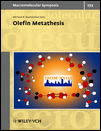TEMPO Containing Polynorbornene Block Copolymers Prepared via ROMP and Their use as Scaffolds in Sol/Gel-Process
Abstract
Summary: Block copolymers (B50T30 and B21T30) containing free nitroxide-radicals with two different chain lengths derived from the monomers (+/−) endo,exo-bicyclo[2,2,1]-hept-5-ene-2,3-dicarboxylic acid-bis-O-tert.-butyl ester (monomer B) and (+/−)endo,exo-bicyclo[2,2,1]-hept-5-ene-2,3-dicarboxylic acid-bis-O-2,2,6,6-piperidinoxyl-ester (monomer T) were polymerized via ring opening metathesis polymerization (ROMP). The ter.-butyl-moiety in block B could then be hydrolyzed to obtain amphiphilic block copolymers which were used as scaffolds in subsequent sol/gel-process. The resulting block copolymers were analyzed via small angle X-Ray scattering (SAXS) to investigate microphase separation and the sol/gel products were analyzed by X-Ray Diffraction (XRD) to prove the formation of ordered TiO2 crystals.




